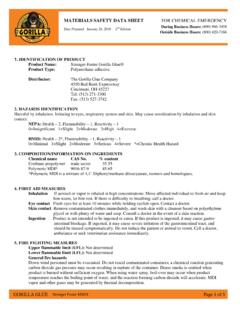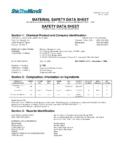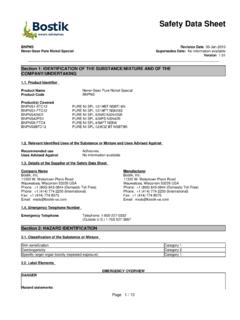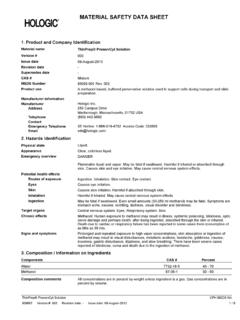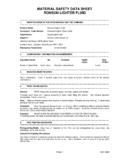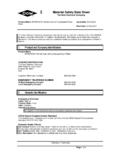Transcription of DOW CORNING CORPORATION Material Safety …
1 DOW CORNING CORPORATION . Material Safety data sheet Page: 1 of 9. Version: Revision Date: 2011/03/13. DOW CORNING (R) 999-A SILICONE BUILDING & GLAZING SEALANT. 1. PRODUCT AND COMPANY IDENTIFICATION. MSDS No.: 03296385. SUPPLIER: Prepared by Product Safety : (800) 248-2481. Dow CORNING CORPORATION NEWALTA: (800) 567-7455. South Saginaw Road Revision Date: 2011/03/13. Midland, Michigan 48686. MANUFACTURER: 24 Hour Emergency Telephone: (989) 496-5900. Dow CORNING CORPORATION South Saginaw Road Midland, Michigan 48686. WHMIS CLASSIFICATION: Class D, Division 2, Subdivision A. Class D, Division 2, Subdivision B.
2 Material Usage: Sealant and adhesive 2. HAZARDS IDENTIFICATION. EMERGENCY OVERVIEW. Generic Description: Silicone Sealant Physical Form: Paste Colour: See product name Odour: Acetic acid Acetic acid is formed upon contact with water or humid air. Provide adequate ventilation to control exposures within guidelines of OSHA PEL: TWA 10 ppm and ACGIH TLV: TWA 10 ppm, STEL 15 ppm. ++++++++++++++++++++++++++++++++++++++++ ++++. POTENTIAL HEALTH EFFECTS. Acute Effects Eye: Direct contact may cause mild irritation. Skin: May cause mild irritation. Inhalation: Irritates respiratory passages very slightly.
3 Oral: Low ingestion hazard in normal use. Prolonged/Repeated Exposure Effects DOW CORNING CORPORATION . Material Safety data sheet Page: 2 of 9. Version: Revision Date: 2011/03/13. DOW CORNING (R) 999-A SILICONE BUILDING & GLAZING SEALANT. Skin: No known applicable information. Inhalation: No known applicable information. Oral: No known applicable information. Other Health Effects This product contains a chemical(s) that has the following effect(s): Reproductive Toxicity Carcinogenicity See Section 11 for specific details. Signs and Symptoms of Overexposure No known applicable information.
4 Medical Conditions Aggravated by Exposure No known applicable information. The above listed potential effects of overexposure are based on actual data , results of studies performed upon similar compositions, component data and/or expert review of the product. Please refer to Section 11 for the detailed toxicology information. 3. COMPOSITION/INFORMATION ON INGREDIENTS. CAS Number Wt % Component Name 7631-86-9 - Silica, amorphous 17689-77-9 - Ethyltriacetoxysilane 4253-34-3 - Methyltriacetoxysilane 1309-37-1 - Iron oxide 13463-67-7 - Titanium dioxide 1333-86-4 - Carbon black 556-67-2 - Octamethylcyclotetrasiloxane 68186-85-6 - Pigment Green 50.
5 The ingredients listed above are controlled products as defined in CPR, am. SOR/88-555. 4. FIRST AID MEASURES. DOW CORNING CORPORATION . Material Safety data sheet Page: 3 of 9. Version: Revision Date: 2011/03/13. DOW CORNING (R) 999-A SILICONE BUILDING & GLAZING SEALANT. Eye: Immediately flush the contaminated eye(s) with lukewarm, gently flowing water for 5 minutes while holding the eyelid(s) open. Obtain medical attention. Skin: No health effects expected. If irritation does occur flush with lukewarm, gently flowing water for 5 minutes. If irritation persists, obtain medical advice.
6 Inhalation: If symptoms are experienced remove source of contamination or move victim to fresh air. If irritation persists, obtain medical advice. Oral: If irritation or discomfort occur, obtain medical advice. Notes to Physician: Treat according to person's condition and specifics of exposure. 5. FIRE-FIGHTING MEASURES. Flash Point: Not applicable. Autoignition Temperature: Not available. Flammability Limits in Air: Not available. Extinguishing Media: On large fires use dry chemical, foam or water spray. On small fires use carbon dioxide (CO2), dry chemical or water spray.
7 Water can be used to cool fire exposed containers. Fire Fighting Measures: Self-contained breathing apparatus and protective clothing should be worn in fighting large fires involving chemicals. Determine the need to evacuate or isolate the area according to your local emergency plan. Use water spray to keep fire exposed containers cool. Unusual Fire Hazards: None. 6. ACCIDENTAL RELEASE MEASURES. Containment/Clean up: Observe all personal protection equipment recommendations described in Sections 5 and 8. Wipe up or scrape up and contain for salvage or disposal. Clean area as appropriate since spilled materials, even in small quantities, may present a slip hazard.
8 Final cleaning may require use of steam, solvents or detergents. Dispose of saturated absorbant or cleaning materials appropriately, since spontaneous heating may occur. Local, provincial, federal laws and regulations may apply to releases and disposal of this Material , as well as those materials and items employed in the cleanup of releases. Note: See Section 8 for Personal Protective Equipment for Spills. Refer to Section 1 to obtain telephone numbers, if additional information is required. DOW CORNING CORPORATION . Material Safety data sheet Page: 4 of 9. Version: Revision Date: 2011/03/13.
9 DOW CORNING (R) 999-A SILICONE BUILDING & GLAZING SEALANT. 7. HANDLING AND STORAGE. Use with adequate ventilation. Product evolves acetic acid (HOAc) when exposed to water or humid air. Provide ventilation during use to control HOAc within exposure guidelines or use respiratory protection. Avoid eye contact. Avoid skin contact. Use reasonable care and store away from oxidizing materials. Keep container closed and store away from water or moisture. This Material in its finely divided form presents an explosion hazard. Follow NFPA 654 (for chemical dusts) or 484 (for metal dusts) as appropriate for managing dust hazards to minimize secondary explosion potential.
10 8. EXPOSURE CONTROLS / PERSONAL PROTECTION. Component Exposure Limits Consult local authorities for acceptable provincial values. CAS Number Component Name Exposure Limits 7631-86-9 Silica, amorphous OSHA PEL (final rule): TWA 80mg/m3 SiO2. NIOSH REL: TWA 6mg/m3. LC50: > mg/l - Inhalation Rat ; 4hr dust/mist LD50: > 3,300 mg/kg - Oral Rat LD50: > 5,000 mg/kg - Dermal Rabbit 17689-77-9 Ethyltriacetoxysilane See acetic acid comments. LD50: 1,460 mg/kg - Oral Rat 4253-34-3 Methyltriacetoxysilane See acetic acid comments. LD50: 1,550 mg/kg - Oral Rat 556-67-2 Octamethylcyclotetrasiloxane Dow CORNING guide: TWA 10 ppm.
